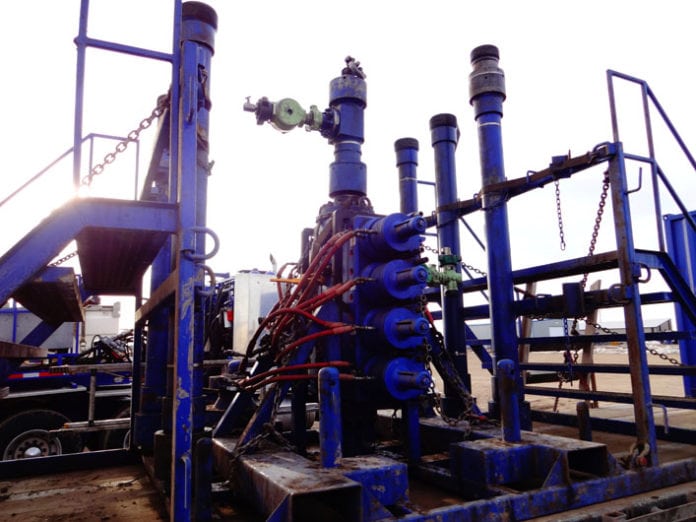Hydraulic fracturing (fracing/fracking) is a very popular well-stimulation method used on many newly drilled wells.
Fracturing basically means creating small fractures in the formation that allow hydrocarbons like oil and gas to flow more easily into the wellbore.
This is achieved by injecting large volumes of fluid under pressure into the formation in order to break the rock and create high permeability fractures in the formation.
Fracturing is often performed on tight formations such as shale that have extremely low permeability.
Often for shale formations, fracturing can be a deciding factor between a profitable well and a failure.
Related: Basic Hydraulic Fracturing Calculations
Hydraulic Fracturing Process
After the well is drilled in most cases it needs to be stimulated to increase production.
The fracturing process consists of pumping a slurry which is a combination of fluid, sand, and chemicals down the well until the formation breaks and fractures are created.
To achieve the required pump rate usually more than one fluid pump is required for the job and in some cases, it can be more than 15 pumps.
The pressure required to create the fracture will depend on the formation gradient of the zone being fracked.
To ensure that the fracture doesn’t close after pressure decreases, proppant (sand particles) is pumped as well.
Small sand particles flow with the fluid into the newly created fracture and settle there.
After pressure decreases, the fracture starts to close but sand helps to keep it open and allows hydrocarbons to flow freely into the wellbore.
Proppant can either be sand or artificially created ceramic beads.
The type of proppant used will depend on the type of formation and downhole forces.
Common fracturing techniques are plug and perf, ball drop, and annular frac with coiled tubing.
Related: What is Proppant?
Typical Frac Equipment
Fluid Pumps – used to pump fluid at high pressure during the frac.
N2 Pumps – are used on frac jobs requiring N2.
Sand Trucks – used to bring sand to the location.
Sand Storage – special large bins used for storing proppant on location. Usually, there is a conveyor belt to move sand from the sand storage to the blender.
Data Van – that’s the trailer from which the crew runs the frac job. Usually, there is a satellite to send real-time frac data to the client and frac engineers in the office.
Blender – used to blend frac chemicals with fluid and sand before this slurry is pumped downhole.
Hydration Unit – used to hydrate dry chemicals such as friction reducer before it is pushed into the blender.
Iron Trucks – used to carry pumping iron.
Chemicals Used in Fracturing
Additionally to sand various chemicals such as friction reducers, gelling agents, and biocides are pumped downhole to make fracturing operations more effective.
Friction reducers are pumped to reduce circulating pressures and lower power consumption by the fluid pumps as well as to assist in carrying proppant downhole.
Depending on the frac, gelling agents are used to increase the viscosity of the fluid in order to improve its sand carrying capacity.
Usually, when gelling chemicals are used, breakers are added as well to break the gel downhole to avoid any type of formation damage.
Biocides are used to kill the bacteria in the frac fluid to prevent it from corroding the equipment and producing unwanted byproducts in the well.
Read next: Top 10 Chemicals Used In Hydraulic Fracturing Process
Fluids Used in Fracturing
A large amount of fluid is required for fracturing operations and water is usually brought to the location and stored in a specialized pool called C-ring before the actual operation begins.
For smaller frac jobs fluid can sometimes also be stored in 400 bbl tanks.
Water is usually the most common fluid used for fracturing
Freshwater is preferred for fracturing operations because it doesn’t interact with frac chemicals and results in lower pumping pressures in comparison to brines.
However often times a mix of recycled brine fluid and fresh is used to lower the costs.
Additionally to water, acids are sometimes pumped as well to prepare the perforations and near-wellbore formation for fracturing.
Related: Working as a Frac Equipment Operator
